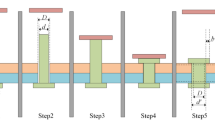Abstract
Evaluation on mechanical properties of a riveted structure with electromagnetic riveting was performed experimentally in this work. The effect of rivet tail dimension on mechanical properties and microstructure evolution were investigated by controlling deformation. The possibility of substituting a riveted structure for a bolted structure was explored by the contrast analysis. Results showed that dislocation slip in the adiabatic shear band was a main deformation mechanism of rivet tail. The rivet tail dimension mainly determined pull-out strength and failure mode of the riveted structure, and the optimal height of rivet tail was 5∼6 mm for this riveted structure. The maximum bearing loads of shear tests and pull-out tests were 23.3 and 35.0 kN, respectively. Both shear strength and pull-out strength of riveted structures exceeded that of bolted structures, where the bolt has similar tensile-loading capacity as the rivet shaft. In contrast to the bolted structure, the load-to-weight ratio values of the riveted structure for shear test and pull-out test were improved by 22.64 and 66.10 %, respectively.
Similar content being viewed by others
References
Groche P, Wohletz S, Brenneis M, Pabst C, Resch F (2014) Joining by forming—a review on joint mechanisms, applications and future trends. J Mater Process Technol 214:1972–1994
Mori KI, Bayn FL, Micari F, Tekkaya AF (2013) Joining by plastic deformation. Ann CIRP Manuf Technol 62:673–694
Chen NJ, Thonnerieux M, Ducloux R, Wan M, Chenot JL (2014) Parametric study of riveted joints. Int J Mater Form 7:65–79
Meschut G, Janzen V, Olfermann T (2014) Innovative and highly productive joining technologies for multi-material lightweight car body structures. J Mater Eng Perform 23:1515–1523
Psyk V, Tisch D, Kinsey BL, Tekkaya AE, Kleiner M (2011) Electromagnetic forming—a review. J Mater Process Technol 211:787–829
Deng JH, Yu HP, Li CF (2009) Numerical and experimental investigation of electromagnetic riveting. Mater Sci Eng A 499:242–247
Wu YC, Huang SY, Chang ZH, Tian ZW (2002) The low-voltage electromagnetic compaction of powder materials. J Wuhan Univ Technol 17:39–42
Oliveira DA, Worswivk MJ, Finn M, Newmanc D (2005) Electromagnetic forming of aluminum alloy sheet: free-form and cavity fill experiments and model. J Mater Process Technol 170:350–362
Xu JR, Cui JJ, Lin QQ, Li CF (2014) Effects of driver sheet on magnetic pulse forming of AZ31 magnesium alloy sheets. Int J Adv Manuf Technol 72:791–800
Xu JR, Yu HP, Li CF (2013) Effects of process parameters on electromagnetic forming of AZ31 magnesium alloy sheets at room temperature. Int J Adv Manuf Technol 66:1591–1602
Choo V, Reinhal PG, Ghassaei S (1989) Effect of high rate deformation induced precipitation hardening on the failure of aluminum rivets. J Mater Sci 24:59–60
Deng JH, Tang C, Fu MW, Zhan YR (2014) Effect of discharge voltage on the deformation of Ti grade 1 rivet in electromagnetic riveting. Mater Sci Eng A 591:26–32
Zhang QL, Cao ZQ, Qin LG, Chen YQ (2013) Numerical simulation of electromagnetic riveting titanium alloy. Rare Metal Mater Eng 42:1832–1837
Feng DG, Cao ZQ (2012) Quality comparing analysis of electromagnetic riveting and pneumatic riveting. Forg StampTechnol 6:62–65
Zhang X, Yu HP, Li J, Li CF (2015) Microstructure investigation and mechanical property analysis in electromagnetic riveting. Int J Adv Manuf Technol 78:613–623
Min JY, Li YQ, Li J, Li JJ, Carlson BE, Lin JP (2015) Friction stir blind riveting of carbon fiber-reinforced polymer composite and aluminum alloy sheets. Int J Adv Manuf Technol 76:1403–1410
Zhang X, Yu HP, Li CF (2014) Multi-filed coupling numerical simulation and experimental investigation in electromagnetic riveting. Int J Adv Manuf Technol 73:1751–1763
Author information
Authors and Affiliations
Corresponding author
Rights and permissions
About this article
Cite this article
Zhang, X., Yu, H.P., Su, H. et al. Experimental evaluation on mechanical properties of a riveted structure with electromagnetic riveting. Int J Adv Manuf Technol 83, 2071–2082 (2016). https://doi.org/10.1007/s00170-015-7729-3
Received:
Accepted:
Published:
Issue Date:
DOI: https://doi.org/10.1007/s00170-015-7729-3




